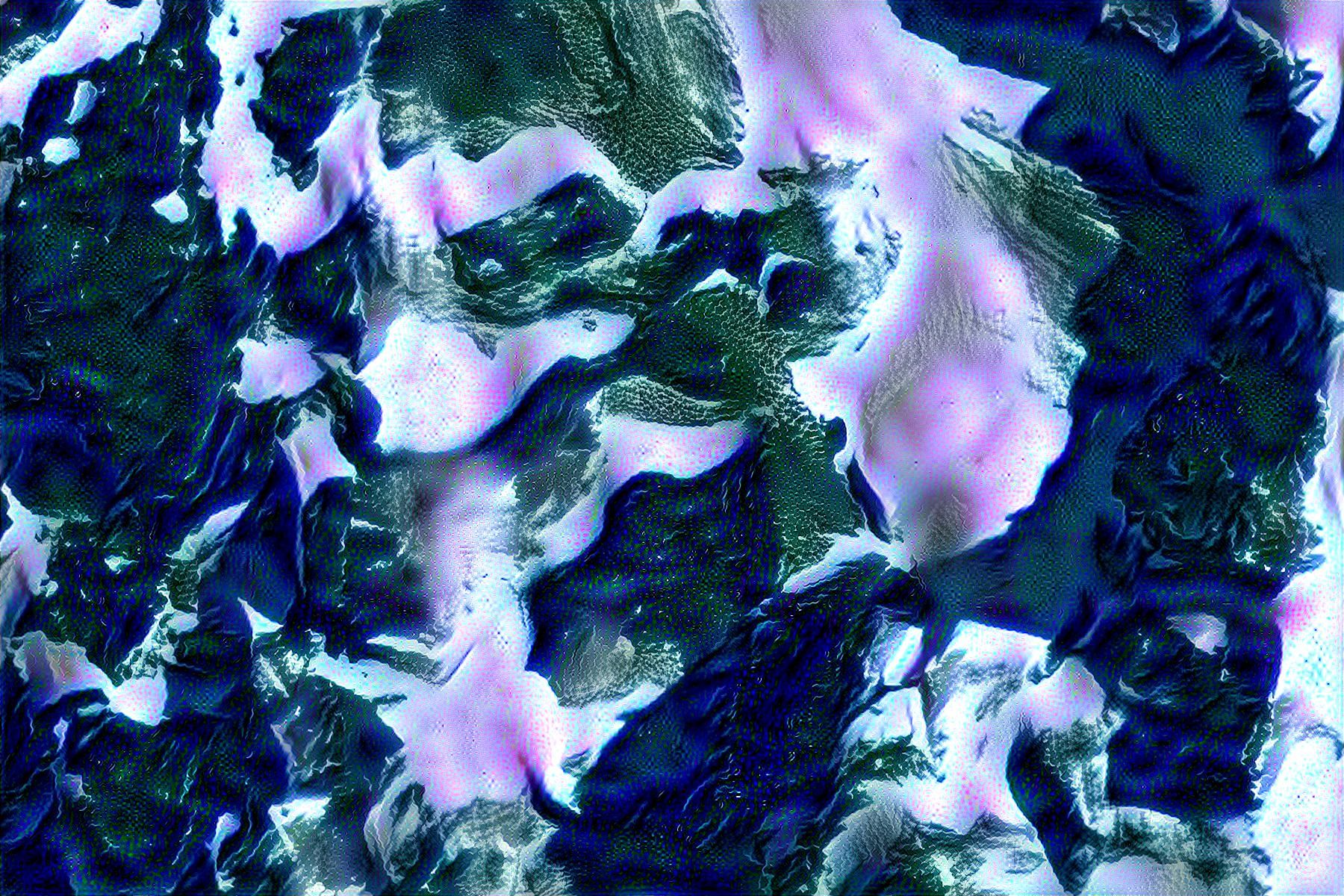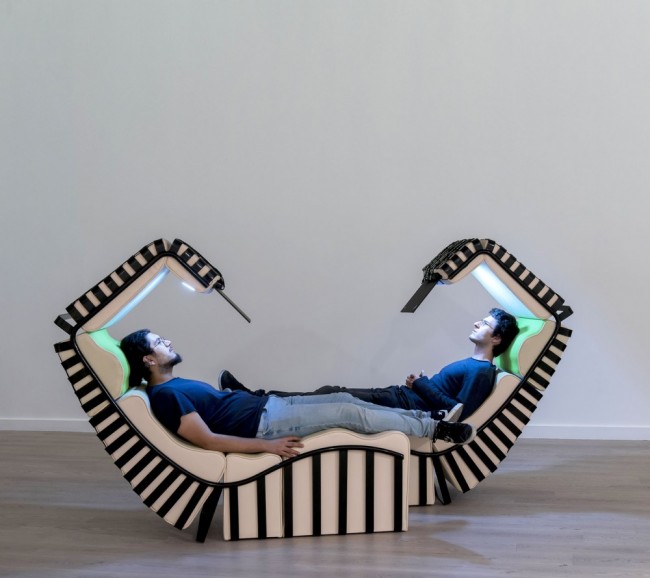Driving the Human: How Scientists, Artists, Architects, and Poets are Coming Up With Creative Solutions to Climate Change

Could AI contribute to solve the climate crisis? This is the central question of Iris Qu’s speculative project, Do AIs Dream of Climate Chaos.
Building a computer out of living plants? Using birds to anticipate natural disasters? Making bacteria speak? They might sound far-fetched, but these are some of the ideas that made it through to the semi-finals of Driving the Human, a program for eco-social renewal sponsored by the German ministry of the environment that seeks to develop responses to the climate crisis. Following an open call in February 2020, which attracted over 1,000 proposals from 99 countries, 21 projects were selected for initial development and shown during a three-day public event in Berlin last fall. PIN–UP spoke to Vera Sachetti, the program’s coordinator, who told us more about the ambitions behind Driving the Human and walked us through the seven finalist projects, which were chosen at the end of last year and whose further development is being funded through 2023.
Andrew Ayers: Vera, can you tell us a little more about Driving the Human — how the program came about and what it’s trying to achieve.
Vera Sachetti: Driving the Human is a three-year initiative funded by the German ministry of the environment, and is a collaboration between four German partners: Forecast, a mentorship program based in Berlin; the ZKM Center for Art and Media Karlsruhe; Karlsruhe University of Arts and Design; and acatech, Germany’s national academy of science and engineering. Located halfway between the arts and the sciences, the program looks at sustainability in all its facets — social, technological, and ecological — and seeks to come up with ideas that will change the urgent situation we find ourselves in now. Things we could start doing tomorrow, some of which will have a more immediate impact than others.
How did you go about launching the program?
We began with a festival jointly hosted by ZKM and the university in Karlsruhe — they invited a lot of smart people to come talk about what is urgent right now for the planet. Then there was the call for proposals, which was launched through the networks of the four partners as well as through the Goethe-Institut, in nine different languages. We had submissions from all over the world — West Java, Ghana, the U.S., Brazil, India, China, just about everywhere. From those we selected 21 initial participants who were given a production grant and an artist’s fee to develop their proposals.

Hyeseon and Seongmin's simulation, The Backpack of Wings: Modern Mythology, set in a dystopian future where birds can’t find their migration routes anymore; but by fitting them with backpack transmitters, humans could help them find their way.
Who was on the jury?
Various people drawn from the four partners. We’re also involving experts from many different fields to act in a mentorship and advice role — a microbiologist, a geographer, a philosopher, a member of Assemble, which is a U.K.-based art and architecture collective, a specialist in circular economics, etc.
And what about you?
I come from the architecture and design world, and work as a design critic and curator. I was attracted to Driving the Human because I find it’s very rare that people are given long-term funding to develop an idea. Generally, it’s never more than six months, meaning that the ideas go nowhere. Here, the seven finalists, who we chose at the end of last year, will have received a total of two years’ support, with production fees for the second stage reaching 40,000 euros each.
So perhaps you could tell us about these seven finalists. Who are they, and what are they proposing?
Akwasi Bediako Afrane is a Ghanaian artist whose project is called TRONS ‘R’ US. He creates creatures that he calls Trons out of discarded pieces of computers and other electronic devices, such as printers, monitors, whatever he finds. He makes an important distinction, in that he’s not using trash, but pieces that still function. He sees them as amputated beings, or living things, that need help, and puts them together to create mutant electronic gadgets. He says he’s looking to amplify the relationship between electronics and people while also critiquing consumer culture.
In complete contrast you have Human-Bacteria Interfaces, a hyper-scientific project that tries to make bacteria speak back to humans. It’s being developed by a group of researchers from Newcastle, U.K., Anne-Sofie Belling, Bea Delgado Corrales, Romy Kaiser, and Paula Nerlich. They’re a super trans-disciplinary team — a textile designer, a materials researcher, biologists — which is also what we wanted to invite. They have this little SCOBY, a petri dish of bacteria that have been impregnated with a luminescent property that they hope will allow them to speak to humans. The idea is that this could be brought into the built environment with potentially tremendous consequences, and that you could learn from them. We keep trying to talk to all these non-human things, but they don’t really seem to be terribly interested in talking back to us. And maybe that’s also fine.

RCA architecture graduates Andra Pop-Jurj and Lena Geerts Danau collaborated as alternaA on Monsters and Ghosts of the Far North: Towards an Inclusive Cartography, a video game that draws on data from the Arctic.
Andra Pop-Jurj and Lena Geerts Danau, who are German-British and go under the collective name alternaA, also look at the non-human, but take a much more geopolitical approach. Recent architecture graduates from London’s RCA, they’ve come up with a project called Monsters and Ghosts of the Far North: Towards an Inclusive Cartography that consists of a video game that draws on data taken from a certain part of the Arctic, which as you know is a very contested region. The ice is melting, new shipping routes are opening up, there are geopolitical claims to the territory, and all the while flora and fauna are dying en masse. Andra and Lena are taking real-time data from these territories and trying to make them palpable in a more embodied way by allowing you to experience the region from the point of view of non-human entities. So, for example, you can play as bacteria that were trapped in the ice and are now being released into the water because the ice is melting. Or you can play as a fish that eats the bacteria, or as a seagull, or an Arctic tern, or a reindeer, or even as a container ship. Using this very atmospheric imagery, they hope to make people conscious of what’s happening in a region of the world that nobody ever thinks about because it’s so remote, inaccessible, and unpopulated. But the future of the planet could hinge on what happens to the melting ice caps. They hope that with this video game they can communicate this urgency.
Data feeds also play a part in Iris Qu’s proposal. She works for a big tech firm in New York, and has come up with a speculative project called Do AIs Dream of Climate Chaos. The starting point is that, in the current state of things, the way artificial intelligence is being used contributes enormously to the climate crisis. She’s trying a little thought experiment: could AI contribute to solving the climate crisis? She’s working on a very hypnotic rendering of AI computing information and knowledge about the climate crisis, and is trying to understand what we might learn from that to help us humans deal with the climate crisis.

Vincent Rumahloine and Mang Dian, who are from West Java, are looking back to forgotten ancestral knowledge. Sedekah Benih examines ancestral agricultural practices to foster a more sustainable idea of harvesting the planet.
Where Iris is looking towards the future of technology, Vincent Rumahloine and Mang Dian, who are from West Java, are looking back to forgotten ancestral knowledge. Sedekah Benih examines ancestral agricultural practices to foster a more sustainable idea of harvesting the planet. In partnership with Mang, who is community chief in Bandung, Vincent started planting an empty plot to spread knowledge about plants and seeds. They started with chili plants — chili being a staple of Indonesian food that became prohibitively expensive during the pandemic — so they began planting and distributing these within the community. They also talked to local musicians who explained to them that, ancestrally, the whole ritual of seeding, planting, and harvesting was accompanied by music. The instrument used was a bamboo karinding, traditionally played during seeding because the frequency of the sound it emits makes insects move away, so it would make the practice of seeding a bit easier. Then, once you stop playing it, the insects come back again. It would be played again during harvesting, but they would never seed or harvest the whole field at once, always leaving a bit for the insects. In other words, it’s a very symbiotic, respectful way of living and working with the planet. On the one hand, Vincent and Mang are connecting to all this ancestral knowledge that was largely erased during colonial times, and on the other they’re creating a community center, because this is a place where people have been gathering. The government has become very interested to the point that they’ve been given 35 other community gardens to manage in West Java.
Hyeseon Jeong and Seongmin Yuk, who are from Korea, have come up with a completely bonkers simulation called The Backpack of Wings: Modern Mythology. It intertwines two seemingly unrelated phenomena. Firstly, East Asian mythology about how animals can feel natural disasters and catastrophes before humans can — not so mythological it turns out, since it’s been scientifically proven that animals do react very early to earthquake stimuli, and that’s why they flee beforehand. Secondly, humans’ data-tracking of animals: migratory birds, fish, all sorts of species. So Hyeseon and Seongmin have imagined this dystopian future where the world is completely destroyed and birds can’t find their migration routes anymore; but by fitting them with transmitters, in the form of little backpacks, humans could help them find their way, while the birds could tell humans whenever they sense natural catastrophes — which, with the climate crisis, are likely to occur more and more frequently. So it would be a win-win situation. Well, the jury’s still out on whether the birds have a say in this and really think it’s a good idea.
Eliana Otta, who’s from Peru, takes a poetical-political approach. Her project is called Virtual Sanctuary for Fertilizing Mourning, and looks at a region in the Peruvian Amazon where indigenous leaders have been assassinated because of mining interests. This has happened all over South America and other parts of the world as well. She tries to counter the colonial attitude of mining companies, which present these territories as lush, natural, and uninhabited, when in fact they have been inhabited for millennia, and are repositories of centuries of knowledge, and contain communities that depend on, nourish, and are stewards of the land. She went to Peru, where two indigenous leaders were assassinated recently, to document what happened and to bring it to a larger audience. Her work is very poetic and emotional, and includes meditation sessions that try to emulate a state of being that is more symbiotic, in the way that these communities understand their place on the planet. In her project description she wrote something very beautiful: she said that, in certain parts of the world, climate crisis isn’t something you can think about later, because these little apocalypses have been happening every day since time immemorial. So the climate crisis is not a past or a future urgency, but one that is with us constantly, forever.
Interview by Andrew Ayers.

